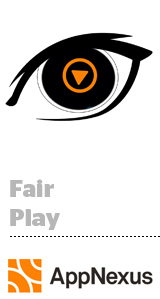 After a late start, AppNexus is continuing to double down on video.
After a late start, AppNexus is continuing to double down on video.
The company launched a closed beta for video viewability measurement and reporting across its platform on Tuesday. The plan is to move into open beta by the end of Q2.
The announcement comes a little less than three months after AppNexus took the wraps off its video SSP, which is still in closed test mode with about a dozen publishers in the US and Europe. AppNexus is already in market with a video buying product, which first hit the scene in September.
The video viewability tool is baked into both the buying and selling sides of the platform. It isn’t accredited by the Media Rating Council yet – that’s on the road map – but it does support the MRC video viewability standard of 50% in-view for two seconds and the far more stringent GroupM standard of 100% in-view for 50% of the video’s duration with the sound on and autoplay off.
Although MRC accreditation is still in the works, AppNexus is offering its video viewability solution for free.
There’s a reason for that: to “reduce the ad tech tax and bring down the cost so that buyers can improve their margins,” said Eric Hoffert, SVP of video technology at AppNexus.
“Our primary goal is to have a fully transparent solution where publishers are awarded for high-quality inventory and clients can find that inventory. It’s consistent with our vision of creating a better video internet,” said Hoffert, noting that AppNexus has been making a big effort around inventory quality. “There are too many intermediaries.”
That’s something Twelvefold Media CTO Jay Budzik has experienced firsthand. Twelvefold’s business revolves around tracking what people read on web pages that carry exchange-traded media and targeting people based on signals gathered from the context of the surrounding content.
Twelvefold does all of its display buying through AppNexus, but before it transitioned to video in early 2016 the company was spending several million dollars a year to maintain a custom-built solution that attempted to model data signals out of AdX inventory.
Budzik and his team have since been able to shut that project down, save the cash Twelvefold was expending on maintenance and assign the engineers who had been working on it to other projects. They’ve also cut video campaign execution time by half, Budzik said.
“There really is a benefit to having one platform doing all your display buying and also having video as a capability in the same ecosystem with viewability, which is top-of-mind for advertisers,” Budzik said.
In March, Twelvefold, a member of Integral Ad Science’s certified viewability partner program, started offering its clients a 100% in-view guarantee on display. Video is far more nascent than the display space, so guarantees aren’t on the table, but Budzik said he’s able to use AppNexus’ video viewability solution to assure clients when their video viewability and completion rate goals are achievable at particular prices.
Of course, that doesn’t obviate the need for third-party verification partners. AppNexus still works with Moat, DoubleVerify and Integral Ad Science.
“Many agencies require them as their system of record and we respect that,” Hoffert said.
Although the “fox can’t guard the henhouse,” said Budzik, Twelvefold is able to use AppNexus’ viewability solution to help plan and optimize tricky campaigns. In some cases, the data Twelvefold uses for targeting is highly proprietary.
Say a food-related client wants to target users based on an interest in gourmet food or an interest in meat-and-potatoes-style cooking, and it turns out that people who like casserole have a far better video completion rate than people who go for haute cuisine.
“We can’t see that with third-party reporting, but when all of the video and viewability metrics are baked into one platform where I also have all of my data, I can see differentiated performance based on content signals,” Budzik said. “That lets us do optimization using our data, whereas before it wasn’t really possible. ”













